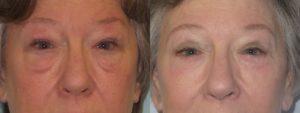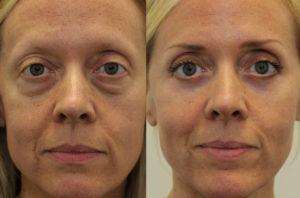What is the best way to have lower eyelid blepharoplasty surgery, skin pinch or transconjunctival?
The short answer is: it depends, and there is a third option. Below is the detailed answer.
If you’ve been thinking about lower eyelid lift surgery, or blepharoplasty, you may have learned about 2 different approaches to lower eyelid rejuvenation:
- The skin approach: an incision is made underneath the eyelashes on the eyelid skin to remove skin and/or fat, tighten muscles, and reposition loose eyelid tissues. This approach is also called subciliary or “skin pinch” (if only a strip of skin is being removed).
- The “behind the eyelid” approach or transconjunctival blepharoplasty: the incision is made through the mucous membrane on the back side of the eyelid called the conjunctival surface. This approach is primarily used for fat removal or repositioning and leaves no visible incision or scar on the front of the eyelid.
Example of lower eyelid surgery with skin pinch (skin incision under eyelashes) and removal of fat bulges
The third approach to lower eyelid blepharoplasty surgery
There’s another option that doesn’t lock you in to just “in front” or “behind” the eyelid. It’s a customized technique that uses a combination of procedures that gives you a plan based on your structure and the way you’ve aged.
A combination approach can include both skin pinch surgery with transconjunctival fat repositioning at the same time for example.
Why would you want to have incisions on both the front and the back of the eyelid? Because it allows your surgeon to sculpt bulging eye fat pads and tighten loose eyelid skin with an inconspicuously placed incision while leaving the eyelid muscle (called the orbicularis muscle) and it’s underlying fascia (the suborbicularis fascia) intact.
Why is leaving the eyelid closure muscle undisturbed so beneficial? Because it reduces the risk of a complication called lower eyelid retraction where the eyelid pulls downward after surgery, changing the shape of the eye. It also allows the eyelid muscle to maintain it’s closing function which important in preventing dry eyes after surgery.
Before and after lower eyelid surgery with incision behind the eyelid combined with under-eye fat injections and laser skin resurfacing
What are some combination procedures that make the lower eyelids look younger?
Not everyone needs two eyelid incisions to achieve their best look. There are some (a small group) of people that benefit from just transconjunctival fat pad removal and will look amazing. But this tends to be most appropriate for young people with bulging under-eye fat as a family trait.
Some customized lower eyelid combinations that I’ve performed in the last year include:
- Transconjunctival approach with laser skin resurfacing or chemical peel
- Skin pinch with lower eyelid tendon tightening (canthopexy or canthoplasty)
- Transconjunctival approach with skin pinch and under eye fat injections (fat grafting)
- Skin pinch with orbicularis muscle suspension and fat grafting and skin resurfacing
- Transconjunctival approach plus midface lift and eyelid tendon tightening
- Transconjunctival fat repositioning with eyelid tendon tightening
My point is that you don’t have to choose between “front” or “back” blepharoplasty when you choose to work with a cosmetic eyelid plastic surgery specialist that has an array of techniques and approaches that are selected to suit you and your needs.
What to do if you want a customized lower eyelid lift surgery
Make several appointments with cosmetic eyelid surgery specialists in your area. I suggest starting with oculoplastic surgeons but you may also consider facial plastic surgeons and general plastic surgeons if they have considerable experience with eyelids (based on the photos they show you, patient testimonials and reviews, and your conversation with them during a consultation). You can find local eyelid surgery specialists by looking at the directory on ASOPRS.org , a website that lists fellowship-trained eyelid and face surgery specialists that passed the only oculoplastic certifying exam.
During your consultation ask for your prospective surgeon’s suggestion based on their examination. Ask if there are alternative approaches and if a combination of procedures could give you a better result than a single one. Then ask to see photographic examples of that approach or combination of techniques.
This is important: make sure your doctor is listening to your goals and concerns and that you are both on the same page with the expected outcome.


